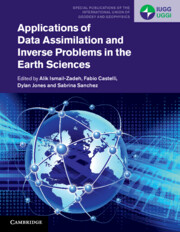Book contents
- Applications of Data Assimilation and Inverse Problems in the Earth Sciences
- Series page
- Applications of Data Assimilation and Inverse Problems in the Earth Sciences
- Copyright page
- Contents
- Contributors
- Preface
- Acknowledgements
- Part I Introduction
- Part II ‘Fluid’ Earth Applications: From the Surface to the Space
- 5 Data Assimilation of Seasonal Snow
- 6 Data Assimilation in Glaciology
- 7 Data Assimilation in Hydrological Sciences
- 8 Data Assimilation and Inverse Modelling of Atmospheric Trace Constituents
- 9 Data Assimilation of Volcanic Clouds: Recent Advances and Implications on Operational Forecasts
- 10 Data Assimilation in the Near-Earth Electron Radiation Environment
- Part III ‘Solid’ Earth Applications: From the Surface to the Core
- Index
- References
8 - Data Assimilation and Inverse Modelling of Atmospheric Trace Constituents
from Part II - ‘Fluid’ Earth Applications: From the Surface to the Space
Published online by Cambridge University Press: 20 June 2023
- Applications of Data Assimilation and Inverse Problems in the Earth Sciences
- Series page
- Applications of Data Assimilation and Inverse Problems in the Earth Sciences
- Copyright page
- Contents
- Contributors
- Preface
- Acknowledgements
- Part I Introduction
- Part II ‘Fluid’ Earth Applications: From the Surface to the Space
- 5 Data Assimilation of Seasonal Snow
- 6 Data Assimilation in Glaciology
- 7 Data Assimilation in Hydrological Sciences
- 8 Data Assimilation and Inverse Modelling of Atmospheric Trace Constituents
- 9 Data Assimilation of Volcanic Clouds: Recent Advances and Implications on Operational Forecasts
- 10 Data Assimilation in the Near-Earth Electron Radiation Environment
- Part III ‘Solid’ Earth Applications: From the Surface to the Core
- Index
- References
Summary
Abstract: During the past two decades, there have been significant efforts to better quantify emissions of environmentally important trace gases along with their trends. In particular, there has been a clear need for robust estimates of emissions on policy-relevant scales of trace gases that impact air quality and climate. This need has driven the expansion of the observing network to better monitor the changing composition of the atmosphere. This chapter will discuss the use of various data assimilation and inverse modelling approaches to quantify these emissions, with a focus on the use of satellite observations. It will discuss the inverse problem of retrieving the atmospheric trace gas information from the satellite measurements, and the subsequent use of these satellite data for quantifying sources and sinks of the trace gases.
Keywords
- Type
- Chapter
- Information
- Publisher: Cambridge University PressPrint publication year: 2023



